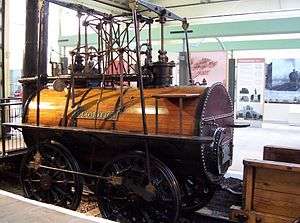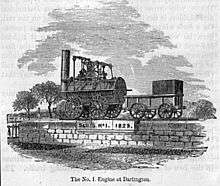Locomotion No. 1
Locomotion No. 1 (originally named Active) was an early steam locomotive built by the pioneering railway engineers George and Robert Stephenson at their manufacturing firm, Robert Stephenson and Company. It became the first steam locomotive to haul a passenger carrying train on a public railway, the Stockton and Darlington Railway (S&DR).
| Locomotion No. 1 | |||||||||||||||||||||||||
|---|---|---|---|---|---|---|---|---|---|---|---|---|---|---|---|---|---|---|---|---|---|---|---|---|---|
 Locomotion at Darlington Railway Centre and Museum | |||||||||||||||||||||||||
| |||||||||||||||||||||||||
| |||||||||||||||||||||||||
| |||||||||||||||||||||||||
| |||||||||||||||||||||||||
Locomotion No. 1 was ordered by the Stockton and Darlington Railway Company in September 1824; its design benefitted from George Stephenson's experience building his series of Killingworth locomotives. It is believed that Locomotion No. 1 was the first locomotive to make use of coupling rods to link together its driving wheels, reducing the chance of the wheels slipping on the iron rails. However, the centre-flue boiler proved to be a weakness, providing for a poor heating surface compared to later multi-flue boilers.
In September 1825, Locomotion No. 1 hauled the first train on the Stockton and Darlington Railway, and became the first locomotive to run on a public railway. On 1 July 1828, it was heavily damaged when its boiler exploded at Aycliffe Lane station, resulting in the death of its driver, John Cree. It was rebuilt but, as a consequence of the rapid advances in locomotive design, Locomotion No. 1 became obsolete within a decade. It was used on the railway until 1841, after which it was converted into a stationary engine. In 1857, as a consequence of its historical importance, Locomotion No. 1 was preserved and put on display. Between 1892 and 1975, it was on static display at one of the platforms at Darlington Bank Top railway station. It is presently at the Head of Steam museum. A working replica of Locomotion has also been built and following years of operation at Beamish Museum it is now currently on static display in Darlington at the Head of Steam Museum.
History
Origins
On 23 June 1823, the pioneering locomotive manufacturer Robert Stephenson and Company was established by the railway engineers George Stephenson and his son Robert Stephenson, and the businessmen Edward Pease and Thomas Richardson.[5] In November of that year, only months after the company started operations, a key order was placed by the Stockton & Darlington Railway Company for four stationary engines.
On 16 September 1824, the S&DR ordered a pair of steam locomotives, at a price of £550 (about £44324 today) each. This order was historically important as the first of these locomotives, Active (later renamed Locomotion No. 1), was the first steam locomotive to haul a passenger train on a public railway.[6]
Design

The design of Locomotion combined and built on the improvements that George Stephenson had incorporated in his Killingworth locomotives. The locomotive weighed 6.6 tonnes, with many elements, including the boiler, cylinders and wheels, composed of cast iron, although the frame was timber. There were four 4 feet (1.2 m) diameter driving wheels.[2]
Locomotion No. 1 used high-pressure steam generated in a centre-flue boiler and driving a pair of vertical cylinders, 9 inches (230 mm) in diameter, which were half embedded within the boiler.[2] The boiler had a blastpipe in the chimney. The single flue boiler had a low heating surface-to-water ratio compared to later boiler designs. The maximum speed of Locomotion No. 1 was about 15 mph (24 km/h).[4] A pair of cross-heads above the cylinders transmitted the power through a pair of coupling rods, making use of a loose eccentric valve gear.[7] Locomotion No. 1 is believed to have been the first locomotive to use coupling rods to connect its driving wheels together, an approach which considerably decreased the chance of slipping.[8]
According to author H. C. Casserley, Locomotion No. 1 is most notable for being the first locomotive to haul a passenger train on a public railway than for the innovations in its design.[9]
Operations
The completed Locomotion No.1 was transported by road from Newcastle to Darlington in September 1825.[10] On 26 September, the day before the opening of the Stockton and Darlington Railway, the locomotive was taken on a trial run between Shildon and Darlington, with a number of the railway’s directors aboard the railway’s first passenger coach, known as ‘’Experiment’’.[6] The driver was James Stephenson, the elder brother to George Stephenson, who had to perch on a small platform beside the boiler; the fireman, William Gowling, stood on a footplate between the engine and the tender.[10]
On 27 September 1825, Locomotion No.1 hauled the first train on the Stockton and Darlington Railway, driven by George Stephenson.[8] The train consisted of Locomotion No.1, eleven wagons of coal, the carriage ‘’Experiment’’, and a further 20 wagons of passengers, guests, and workmen. Around 300 tickets had been sold but about twice as many people were believed to have been aboard. The train, which had an estimated weight of 80 tonnes was about 400 feet (120 m) long, reached a maximum speed of 12 miles per hour (19 km/h)), and took two hours to complete the first 8.7 miles (14.0 km) of the journey to Darlington, but was slowed by a derailed wagon and a blocked feed pump valve, thus only achieving an average speed of 8 miles per hour (13 km/h).[6]
Locomotion No. 1 continued to haul trains on the S&DR for three years. On 1 July 1828, the locomotive was heavily damaged when the boiler exploded while the train was stopped at Aycliffe Lane station, resulting in the death of the driver, John Cree, and the wounding of water pumper, Edward Turnbull.[11] Cree had tied down the arm of a safety valve, which caused the boiler pressure to rise to the point of explosion.[10]
Locomotion No. 1 was rebuilt and returned to service and ran until 1850.[2] On 4 June 1846, it hauled the opening train on the Middlesbrough and Redcar Railway, a subsidiary of the S&DR.[12]
Following its withdrawal, ‘’Locomotion’’ was purchased by Joseph Pease and Partners, converted into a stationary pumping engine for use at their West Collieries in South Durham, where it was used until 1857.[2]
Preservation
In 1856, Joseph Pease and his family spent £50 to restore Locomotion No. 1; it was one of the first locomotives to be restored for preservation. It had remained on the books of the S&DR Company.
On a hot Saturday, 6 June 1857 at 1 pm with flags flying outside the North Road station near the Alfred Kitching works, a band and procession arrived for the ceremony of laying the foundation for a pedestal on which to erect Locomotion No. 1. The task was to have fallen to Edward Pease – an invitation to do that declined by letter read out on the day – it concluded 'declining the kindness of your proposition, I subscribe myself, with much respect, your friend, Edward Pease. The abundance of my years must apologise for very much in this letter.'
The stone was instead laid by the S&DR treasurer & Edward's son Joseph Pease. Cannon were fired in celebration. Speeches were made.
The late Mr George Stephenson was remembered and his son Robert, along with Hackworth and Murray. Mr Thomas MacNay addressed the crowd as did John Dixon, and a speech made by Henry Pease from the newly laid stone, included his rejoicing 'in the fact that their first locomotive [Locomotion No. 1] was about to be placed in a suitable position, so as to hand down to posterity a memorial of one of the greatest events the civilised world ever witnessed'. The crowd cheered.
A procession of the railway officials [about 70] made their way to the Sun Inn for a meal, further speeches were made, toasts made and their meeting held. They adjourned to Pierremont, the home of Henry Pease, for tea and entertainment of cricket, quoits etc in the grounds.[13]
Between 1857 and the 1880s, it was usually on the pedestal display at Alfred Kitching's workshop near the Hopetown Carriage Works. It was on exhibition in Philadelphia in 1876, Newcastle in 1881, Chicago in 1883, Liverpool in 1886, Newcastle in 1887, Paris in 1889, Edinburgh in 1890. Locomotion No.1 was steamed for the Stockton and Darlington Railway's Golden Jubilee in September 1875, as well as to participate in a procession of locomotives at the George Stephenson Centenary, in June 1881.[10] Locomotion always returned to its static display in Darlington, the headquarters of the Stockton and Darlington Railway Company.
From 1892 to 1975, Locomotion was on static display along with Derwent, another early locomotive, on one of the platforms overlooking the S&DR line to Saltburn-by-the-Sea at Darlington's main station Bank Top. During 1924, it was cosmetically restored. During the Second World War, it was temporarily relocated [at Stanhope] due to the threat of bombing.[10]
The locomotive is now on display at Head of Steam, in the same building as Darlington's North Road station, on long-term loan from the National Railway Museum, and is part of the National Collection, although it has remained in Darlington for 163 years [to 2020.]
The original locomotive is too fragile to return to steam, so a working replica was built in 1975, and is resident at Beamish Museum.[14]
See also
- Locomotive No. 1 The first locomotive in New South Wales.
- Tom Thumb The first American steam locomotive
References
- Ross, David (2004). British steam railways. Bath: Parragon. p. 15.
- "The Origin and Progress of Steam Locomotion". The Engineering News. McGraw-Hill Publishing Company. 2: 143–146. 1875.
- Casserley, H.C. (1960). Historic locomotive pocket book. London: Batsford. p. 7.
- "Locomotion No. 1, George Stephenson and the world's first public railway".
- Stretton, Clement E. (June 1897). "Early Engines of Stephenson and Company". The Railway World.
- Bowes, Alderman (1883). George Stephenson, the Locomotive and the First Public Railway: A Lecture Delivered at the Salford Royal Museum and Library. John Heywood.
- The British railway locomotive 1803–1850. London: Science Museum. 1958. p. 11.
- Hamilton, Ray (10 May 2018). For the Love of Trains: A Celebration of the World's Railways. Summersdale Publishers Ltd.
- Casserley, H.C. (1976). Preserved locomotives (4th ed.). London: Ian Allan. p. 16. ISBN 071100725X.
- "Locomotion No.1, Stockton & Darlington Railway". engineering-timelines.com. Archived from the original on 19 June 2018. Retrieved 19 June 2018.
- Hewison, Christian H. (1983). Locomotive Boiler Explosions. Newton Abbot: David & Charles. p. 26. ISBN 0715383051.
- "News". The Railway Magazine. Vol. 57. 1925.
- D&S Times 13 June 1857
- Satow, F.; Satow, M.G.; Wilson, L.S. (1976). Locomotion — concept to creation: the story of the reproduction 1973–1975. Beamish: Locomotion Trust.
External links
| Wikimedia Commons has media related to Locomotion No.1. |